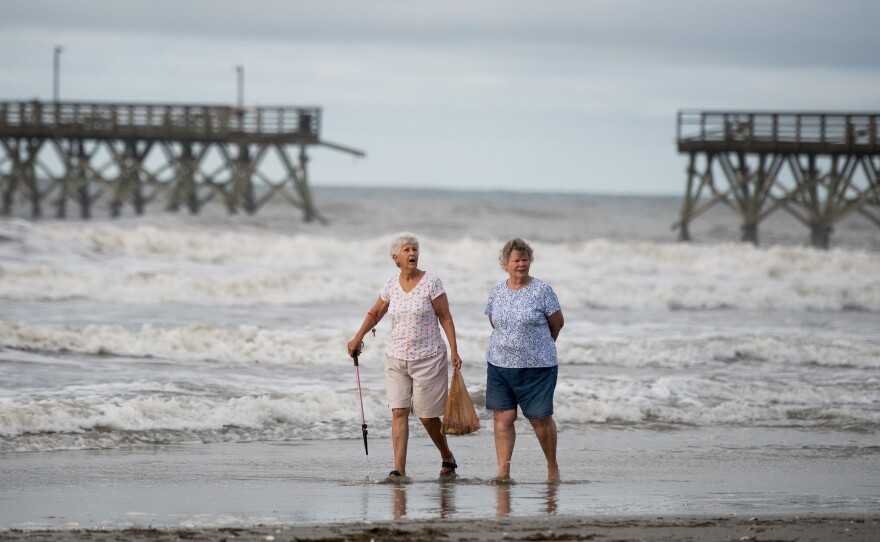Updated at 12:30 p.m. ET
Isaias is flooding low-lying areas of South Carolina, North Carolina and Virginia as it plows its way up the Mid-Atlantic coast. Isaias is now a tropical storm after hitting the shore as a hurricane late Monday night. It's bringing threats of flash flooding and tornadoes as it heads to the Northeast.
At least one death has been reported from the system. That person was killed when a tornado struck Bertie County, Mike Sprayberry, North Carolina's Emergency Management director, told NPR's Morning Edition.
"It hit a couple of mobile home parks, and we experienced one fatality and a number of injuries," Sprayberry said.
Emergency and utility crews are working to clear roads and assess any structures that were flooded, he added.
Isaias remains fearsome: Roughly 12 hours after landfall, it is still clocking sustained winds of 70 mph, according to the NHC's 11 a.m. ET update. Just before 9 a.m., a weather station at York River East in Virginia reported wind gusts up to 94 mph, the National Hurricane Center said.
"Very heavy rainfall and life-threatening flash and urban flooding are expected along the storm's track up the Eastern Seaboard," the National Weather Service said. "A few tornadoes will be possible from the Virginia Tidewater into New England."
At 10 a.m. ET, the hurricane center reported tornadoes over eastern Maryland and the Delmarva Peninsula. Tornado watches are in effect Tuesday for a 60-mile area that runs from south of Philadelphia to the northeast of Bridgeport, Conn., according to the NWS Storm Prediction Center .
The storm center said a band of "persistent low-topped supercells ... should rapidly move north-northeast across parts of the Northeast Megalopolis into this afternoon."
Isaias made landfall in North Carolina around 11:10 p.m. ET Monday, blasting ashore with sustained winds of 85 mph near Ocean Isle Beach, N.C., just above the border with South Carolina, the National Hurricane Center said.
Nearly 370,000 power outages have been reported in North Carolina, the state's Emergency Management division said Tuesday morning. Most of those outages are in the eastern half of the state, where at least five counties each report more than 20,000 outages.
"Before coming onshore, it spawned several tornadoes that impacted our county," Brunswick County, N.C., Emergency Services Director Edward Conrow told NPR's Morning Edition, "particularly Bald Head Island, which is a remote island only accessible by ferry, with several thousand people on it.
Tornadoes hit several parts of Brunswick County, Conrow said. "We actually had one possibly pass right by our emergency operation center. And then we were hit with the hurricane-force winds."
In addition to damage from high winds and a storm surge, Conrow said, "We had numerous homes burned. We had some rescues that went underway early this morning, in the dark hours."
Anyone still in the storm's path should expect its arrival soon: Isaias is rushing toward the north-northeast, moving at 35 mph as of 11 a.m. ET. Its forward motion has sped up consistently after coming ashore moving around 22 mph. And its effects arrive even sooner, as outer bands of rain stretch for hundreds of miles. Isaias is extending tropical storm-force winds outward up to 140 miles.
Strong winds snapped thick pine trees in Suffolk, Va., west of Virginia Beach, damaging multiple homes and prompting the city to open an emergency shelter in a high school. A hotel roof was also blown off, according to Kiahnna Patterson of local TV news station WAVY. She added that local officials believe a tornado may have touched down in the area.
Since its center moved over land, the storm has weakened very slowly, maintaining strong winds that can down trees and cause power outages.
"A faster rate of weakening is expected to begin tonight, and the system is forecast to become post-tropical tonight or early Wednesday," the NHC said.
The center of the storm is now about 70 miles southwest of Philadelphia — but Isaias' surge of ocean water still poses a dire threat for a broad swath of the coast.
Over the past 12 hours, Isaias has put roughly 1,000 miles of the U.S. East Coast under a storm surge warning, from Folly Beach, S.C., near Charleston, to Martha's Vineyard, Mass. The current outlook warns of a peak surge of 3-5 feet for much of North Carolina's coastline, and of 1-3 feet for areas to the north, including the Chesapeake Bay and Delaware Bay.
The system is bringing heavy rain and strong winds far inland. In just one hour, Isaias dropped an inch of rain in Raleigh, N.C., the National Weather Service's office there reported. The city is about 150 miles northwest of Morehead City, on the coast.
As it brings perilous amounts of water, the storm is not expected to linger. By Tuesday night, the weather service said, the center of Isaias will be moving into southern Canada.
Isaias has strained emergency agencies, arriving as the Southeast copes with large numbers of coronavirus cases. Concerns about the potential to spread the virus further forced Florida to suspend testing. Agencies also had to change their plans for handling people stranded by the storm.
"It has really limited the amount of people we could put in shelters safely," Conrow said, adding that the facilities are now required to have isolation areas and to provide personal protective gear.
Copyright 2020 NPR. To see more, visit https://www.npr.org.






